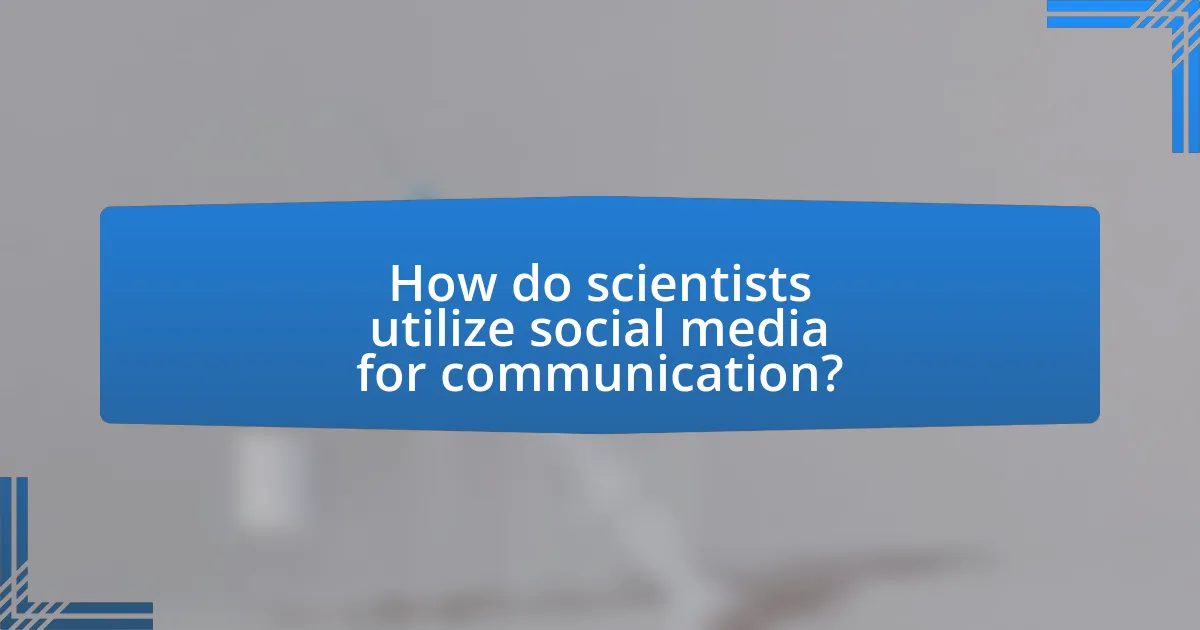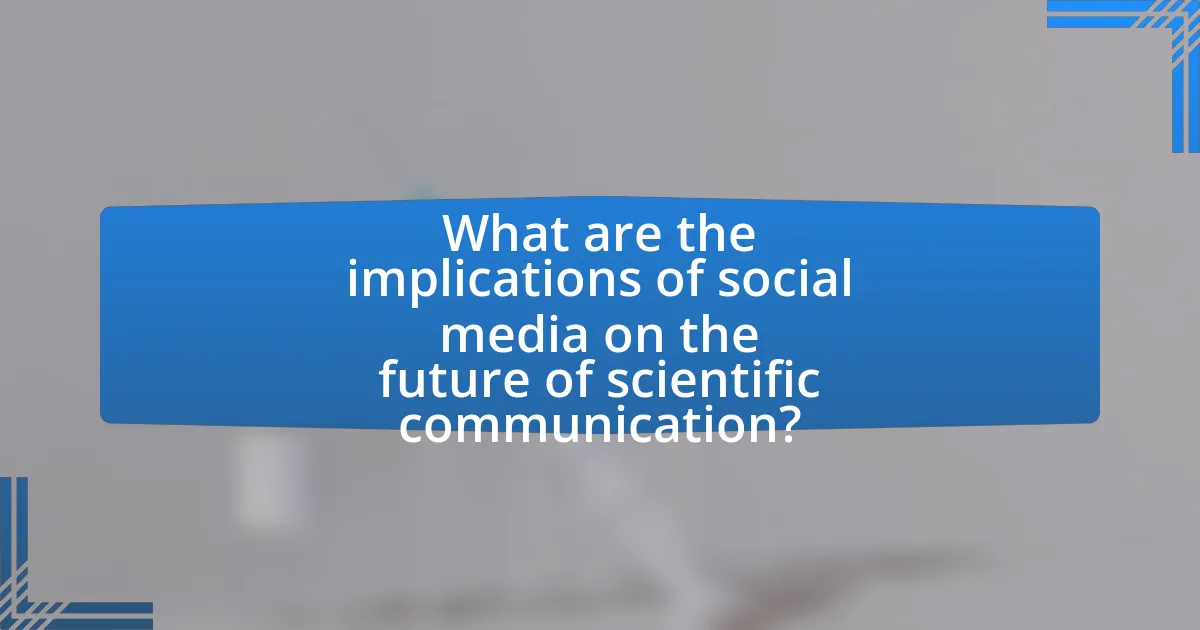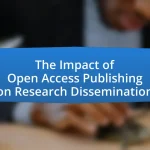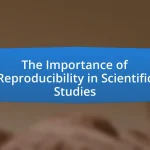The article examines the influence of social media on scientific communication, highlighting its role in enhancing the dissemination and accessibility of research findings. It discusses how platforms like Twitter and Facebook facilitate real-time engagement, increase citation rates, and foster collaboration among scientists across geographical boundaries. The article also addresses the challenges posed by misinformation and the oversimplification of complex topics, emphasizing the importance of understanding social media’s impact on public engagement with science. Key platforms influencing scientific discourse, strategies for effective communication, and best practices for maintaining credibility are also explored, along with the implications for the future of scientific communication.

What is the Influence of Social Media on Scientific Communication?
Social media significantly influences scientific communication by enhancing the dissemination and accessibility of research findings. Platforms like Twitter and Facebook allow scientists to share their work with a broader audience, facilitating real-time engagement and discussion. According to a study published in the journal “PLOS ONE,” researchers found that articles shared on social media receive more citations, indicating that social media can amplify the reach and impact of scientific research. Furthermore, social media fosters collaboration among scientists across geographical boundaries, enabling interdisciplinary approaches to complex problems.
How has social media changed the landscape of scientific communication?
Social media has transformed scientific communication by facilitating rapid information dissemination and enhancing public engagement with science. Platforms like Twitter and Facebook allow researchers to share findings instantly, reaching broader audiences beyond traditional academic journals. For instance, a study published in the journal “PLOS ONE” in 2016 found that tweets from scientific articles significantly increased article downloads and citations, demonstrating the impact of social media on research visibility. Additionally, social media fosters direct interaction between scientists and the public, enabling real-time discussions and feedback, which can enhance understanding and interest in scientific topics.
What are the key platforms influencing scientific discourse?
Key platforms influencing scientific discourse include Twitter, ResearchGate, and Google Scholar. Twitter serves as a real-time communication tool where scientists share research updates and engage in discussions, significantly impacting public and academic discourse. ResearchGate allows researchers to share publications and collaborate, fostering a community that enhances visibility and accessibility of scientific work. Google Scholar provides a comprehensive database for academic literature, facilitating the discovery and citation of research, which is crucial for scholarly communication. These platforms collectively shape how scientific information is disseminated and discussed within the academic community and beyond.
How do these platforms facilitate or hinder scientific discussions?
Social media platforms facilitate scientific discussions by providing accessible channels for researchers to share findings, engage with peers, and reach broader audiences. These platforms enable real-time communication, allowing scientists to disseminate information quickly and receive immediate feedback, which can enhance collaboration and innovation. For instance, a study published in the journal “PLOS ONE” found that Twitter usage among scientists increased visibility and engagement with their research, leading to higher citation rates. Conversely, these platforms can hinder discussions by promoting misinformation and creating echo chambers, where users may only interact with like-minded individuals, limiting exposure to diverse viewpoints. Research from the “Journal of Communication” highlights that misinformation can spread rapidly on social media, undermining the credibility of scientific discourse.
Why is understanding this influence important for scientists?
Understanding the influence of social media on scientific communication is crucial for scientists because it shapes how research is disseminated and perceived by the public. Social media platforms enable rapid sharing of scientific findings, which can enhance public engagement and awareness of scientific issues. For instance, a study by the Pew Research Center found that 72% of adults use social media, indicating a significant audience for scientific communication. This understanding allows scientists to tailor their messaging effectively, ensuring that complex information is accessible and engaging to a broader audience, ultimately fostering informed public discourse and promoting science literacy.
What role does social media play in public engagement with science?
Social media plays a crucial role in public engagement with science by facilitating direct communication between scientists and the general public. This platform allows researchers to share their findings, promote scientific literacy, and foster discussions on scientific topics, thereby increasing public interest and understanding of science. For instance, a study published in the journal “PLOS ONE” by researchers at the University of California found that social media can enhance the visibility of scientific research, leading to higher citation rates and broader public discourse. Additionally, social media enables real-time interaction, allowing audiences to ask questions and receive immediate responses, which further enhances engagement and comprehension of scientific concepts.
How can social media impact the dissemination of scientific knowledge?
Social media can significantly enhance the dissemination of scientific knowledge by providing a platform for rapid information sharing and engagement with diverse audiences. This immediacy allows researchers to communicate findings directly to the public, bypassing traditional gatekeepers like journals and conferences. For instance, a study published in the journal “PLOS ONE” by researchers from the University of California found that tweets about scientific articles can increase their visibility and citation rates, demonstrating that social media can amplify the reach of scientific communication. Additionally, platforms like Twitter and Facebook facilitate discussions and collaborations among scientists, educators, and the public, fostering a more informed society.
What challenges arise from the influence of social media on scientific communication?
The challenges arising from the influence of social media on scientific communication include the spread of misinformation, the oversimplification of complex topics, and the prioritization of sensationalism over accuracy. Misinformation can rapidly circulate on platforms like Twitter and Facebook, leading to public confusion about scientific facts, as evidenced by the widespread misconceptions about vaccines during the COVID-19 pandemic. Oversimplification occurs when nuanced scientific findings are condensed into catchy headlines, which can mislead audiences about the implications of research. Additionally, sensationalism often drives engagement metrics, causing researchers to feel pressured to present their work in a more dramatic light, potentially compromising the integrity of the information shared. These challenges hinder effective communication and public understanding of science.
What are the risks of misinformation in scientific discussions on social media?
Misinformation in scientific discussions on social media poses significant risks, including the potential to mislead public understanding and influence health behaviors negatively. For instance, false claims about vaccines can lead to decreased vaccination rates, which has been linked to outbreaks of preventable diseases, as evidenced by the resurgence of measles in areas with low vaccination coverage. Additionally, misinformation can undermine trust in scientific institutions and experts, as seen during the COVID-19 pandemic, where conflicting information led to confusion and skepticism about public health guidelines. This erosion of trust can hinder effective communication and collaboration in addressing critical scientific issues.
How does the speed of information sharing affect scientific accuracy?
The speed of information sharing significantly impacts scientific accuracy by increasing the likelihood of disseminating unverified or erroneous data. Rapid communication channels, such as social media, can lead to the spread of misinformation before thorough peer review or validation occurs. For instance, a study published in the journal “Nature” found that misinformation about COVID-19 spread faster than accurate information, leading to public confusion and misinformed health decisions. This illustrates that while quick sharing can enhance awareness, it often compromises the reliability of scientific information, as the urgency to communicate can overshadow the need for accuracy and verification.

How do scientists utilize social media for communication?
Scientists utilize social media to disseminate research findings, engage with the public, and foster collaboration within the scientific community. By sharing articles, updates, and insights on platforms like Twitter and Facebook, scientists can reach a broader audience beyond traditional academic circles. For instance, a study published in the journal “PLOS ONE” found that tweets from scientists can significantly increase the visibility and citation rates of their published work. Additionally, social media allows for real-time interaction, enabling scientists to respond to questions and engage in discussions, thereby enhancing public understanding of science.
What strategies do scientists employ to engage with the public on social media?
Scientists employ various strategies to engage with the public on social media, including sharing accessible content, utilizing visuals, and fostering interactive discussions. By simplifying complex scientific concepts into layman’s terms, scientists make their work more relatable and understandable. For instance, the use of infographics and videos can effectively convey research findings, as studies show that visual content increases engagement rates significantly. Additionally, scientists often host Q&A sessions or live streams, allowing the public to ask questions directly, which enhances community involvement and trust. Research indicates that these interactive formats can lead to a 30% increase in audience participation compared to traditional posts.
How can scientists effectively share their research findings online?
Scientists can effectively share their research findings online by utilizing social media platforms, academic networking sites, and open-access journals. Social media platforms like Twitter and LinkedIn allow scientists to reach a broader audience, engage with the public, and foster discussions around their work. Academic networking sites such as ResearchGate and Academia.edu enable researchers to share publications and connect with peers, enhancing visibility and collaboration. Open-access journals provide a platform for disseminating research without paywalls, ensuring that findings are accessible to a wider audience. According to a study published in the journal “PLOS ONE,” researchers who actively use social media to share their work can increase citations and public engagement, demonstrating the effectiveness of these online sharing methods.
What are the best practices for maintaining credibility on social media?
To maintain credibility on social media, individuals and organizations should consistently share accurate, evidence-based information while engaging transparently with their audience. This involves verifying facts before posting, citing reputable sources, and correcting any misinformation promptly. Research indicates that users are more likely to trust accounts that demonstrate reliability; for instance, a study published in the Journal of Communication found that transparency and consistency in messaging significantly enhance perceived credibility. Additionally, actively engaging with followers by responding to comments and questions fosters trust and builds a credible online presence.
How does social media facilitate collaboration among scientists?
Social media facilitates collaboration among scientists by providing platforms for real-time communication and information sharing. These platforms enable researchers to connect across geographical boundaries, allowing them to exchange ideas, share research findings, and solicit feedback instantly. For instance, Twitter has been shown to enhance visibility for scientific work, with studies indicating that tweets can increase citations of research articles by up to 20%. Additionally, social media groups and forums foster collaborative projects by bringing together diverse expertise, which can lead to innovative solutions and interdisciplinary research.
What platforms are most effective for scientific collaboration?
The most effective platforms for scientific collaboration include ResearchGate, Academia.edu, and Google Scholar. ResearchGate facilitates networking among researchers, allowing them to share publications and engage in discussions, which enhances collaborative efforts. Academia.edu serves as a platform for sharing research papers and connecting with other academics, fostering collaboration through visibility and networking. Google Scholar provides a comprehensive database of scholarly articles, enabling researchers to discover relevant work and connect with others in their field, thus promoting collaborative research initiatives. These platforms have been shown to increase visibility and accessibility of research, leading to more collaborative opportunities in the scientific community.
How can social media enhance networking opportunities for researchers?
Social media enhances networking opportunities for researchers by providing platforms for collaboration, knowledge sharing, and visibility. Researchers can connect with peers, share their work, and engage in discussions through platforms like Twitter, LinkedIn, and ResearchGate. For instance, a study published in the journal “PLOS ONE” found that 80% of researchers reported using social media to connect with colleagues and share research findings, demonstrating its effectiveness in fostering professional relationships. Additionally, social media allows researchers to reach a broader audience, increasing the impact of their work and facilitating interdisciplinary collaborations.

What are the implications of social media on the future of scientific communication?
Social media significantly alters the future of scientific communication by enhancing accessibility and engagement with research. Platforms like Twitter and Facebook allow scientists to share findings instantly, reaching broader audiences beyond traditional academic circles. This democratization of information fosters public interest and understanding of science, as evidenced by studies showing increased public engagement with scientific topics through social media interactions. Furthermore, social media facilitates collaboration among researchers across the globe, leading to faster dissemination of knowledge and innovative ideas. The implications also include challenges, such as the potential spread of misinformation, which necessitates the development of critical media literacy among both scientists and the public.
How might social media evolve in its role within scientific communication?
Social media may evolve to become a primary platform for real-time scientific communication and collaboration. As researchers increasingly utilize social media for disseminating findings, engaging with the public, and fostering interdisciplinary connections, platforms like Twitter and LinkedIn are already facilitating discussions among scientists and non-scientists alike. A study published in the journal “PLOS ONE” in 2020 found that 80% of scientists use social media to share their research, indicating a growing trend towards digital engagement. This evolution could lead to enhanced transparency in research processes and increased public understanding of science, as social media allows for immediate feedback and broader outreach compared to traditional academic publishing.
What trends are emerging in the use of social media by scientists?
Scientists are increasingly using social media to enhance collaboration, disseminate research findings, and engage with the public. This trend is evidenced by a growing number of scientists utilizing platforms like Twitter and LinkedIn to share their work, with a study indicating that 65% of researchers use social media for professional networking and communication. Additionally, scientists are leveraging social media to participate in discussions around scientific topics, which fosters a more interactive and transparent dialogue with both peers and the general public. This shift towards digital engagement is reshaping how scientific knowledge is shared and consumed, making it more accessible and immediate.
How can scientists prepare for future changes in social media dynamics?
Scientists can prepare for future changes in social media dynamics by actively engaging in continuous education about emerging platforms and trends. This proactive approach allows scientists to adapt their communication strategies effectively, ensuring their research reaches diverse audiences. For instance, a study by the Pew Research Center indicates that 72% of the public relies on social media for news, highlighting the importance of scientists being present on these platforms to disseminate accurate information. Additionally, scientists should collaborate with social media experts to develop best practices for effective communication, thereby enhancing their ability to convey complex scientific concepts in an accessible manner.
What practical tips can scientists follow to maximize their social media impact?
Scientists can maximize their social media impact by consistently sharing engaging content, interacting with their audience, and utilizing relevant hashtags. Engaging content, such as infographics or short videos, increases visibility and shares, as studies show that visual content is 40 times more likely to be shared on social media. Regular interaction with followers fosters community and encourages discussions, which can lead to increased reach and influence. Additionally, using relevant hashtags can enhance discoverability; for instance, posts with at least one hashtag receive 12.6% more engagement than those without. These strategies collectively enhance a scientist’s online presence and effectiveness in communicating their research.
How can scientists create engaging content for their audience?
Scientists can create engaging content for their audience by utilizing storytelling techniques, visual aids, and interactive elements. Storytelling helps to contextualize complex scientific concepts, making them relatable and easier to understand. For instance, research shows that narratives can enhance memory retention and engagement, as demonstrated in a study published in the journal “Cognitive Science” by Green and Brock, which found that stories can significantly improve comprehension and interest. Additionally, incorporating visuals such as infographics, videos, and images can capture attention and simplify information, as studies indicate that visual content is processed 60,000 times faster than text. Lastly, interactive elements like polls, Q&A sessions, and live demonstrations foster audience participation, increasing engagement and interest in scientific topics.
What tools can assist scientists in managing their social media presence?
Tools that can assist scientists in managing their social media presence include Hootsuite, Buffer, and TweetDeck. Hootsuite allows users to schedule posts across multiple platforms, track engagement metrics, and manage interactions in one dashboard, which is essential for maintaining an active online presence. Buffer offers similar scheduling capabilities and provides analytics to optimize posting times and content strategies. TweetDeck, specifically for Twitter, enables real-time monitoring of tweets, mentions, and hashtags, facilitating timely engagement with followers. These tools enhance efficiency and effectiveness in social media management, which is crucial for scientists aiming to communicate their research and engage with the public.


